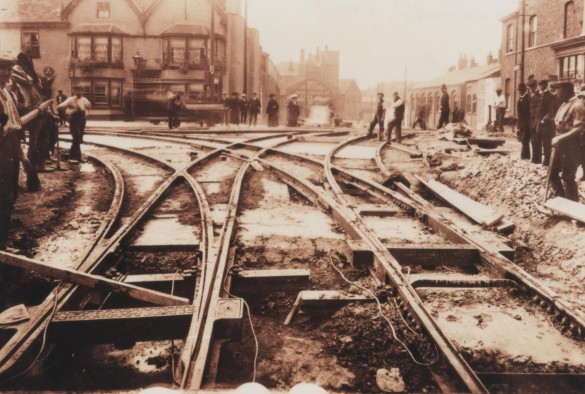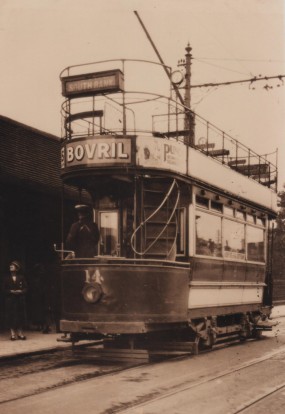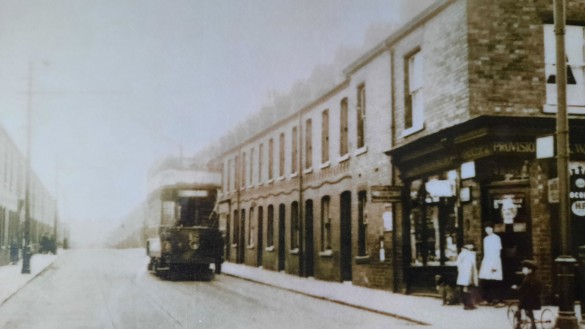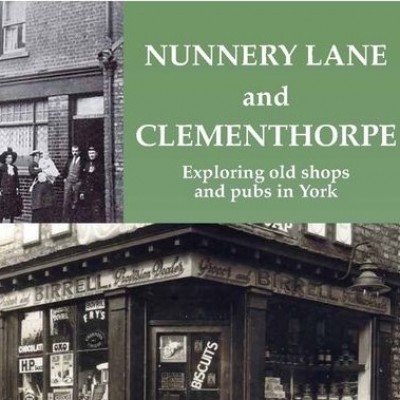04th October 2021
The South Bank Tramway
Keith Watson has written a blog post for us about the tramway running through our area in the early 20th century.
The South Bank Tramway was an electric overhead tramway route from York Railway Station to South Bank, operating between 1913 and 1935.
The story of the South Bank Tramway goes back to April 1909, when a poll of electors voted in favour of replacing the previous horse-drawn tram system by the construction of an electric tramway system. Work commenced in September 1909, and the first route from Fulford opened in 1910.
In October 1911, York Corporation decided to construct a new route, - the 'Bishopthorpe Road or South Bank Route', from York Railway Station to South Bank, via Nunnery Lane, New York St, Bishopthorpe Rd, Balmoral Terrace and Queen Victoria St, terminating opposite the Post Office, at the junction with Albermarle Rd.

Construction of the tram line at the junction of Nunnery Lane and Blossom St 1913
This planned tramway extension was to be a track gauge of 3 ft 6 ins, using the overhead line system running just over 1 mile, 1 furlong and 3.7 chains in length, from a junction with the existing lines at the corner of Nunnery Lane and Blossom St. It was to be of double track throughout, except for one short length of single track in Balmoral Terrace and Queen Victoria St. The total estimated cost of the extension (including the cost of additional new tramcars that were required) amounted to £16,440. New tramcars were ordered in December 1911 - open top double decker type, with an open staircase, canopy platform, 30 upper deck seats, and 22 lower deck seats. Livery was royal blue and ivory cream, with lining and lettering in gold the words 'City of York Tramways', plus the City coat of arms. These additional tramcars were delivered in 1912.
 That year the South Bank Tramway (Light Railways Extension) Order was obtained, authorising the construction of the South Bank Tramway. Work commenced on 25 March 1913 and the tramway was opened on Wednesday, 30 July 1913, with traffic running from York Railway Station to the South Bank terminus in Queen Victoria St. There were two tramway shelters built along the route – one half way down Nunnery Lane and the other at the junction with Bishopthorpe Rd and Ebor St.
That year the South Bank Tramway (Light Railways Extension) Order was obtained, authorising the construction of the South Bank Tramway. Work commenced on 25 March 1913 and the tramway was opened on Wednesday, 30 July 1913, with traffic running from York Railway Station to the South Bank terminus in Queen Victoria St. There were two tramway shelters built along the route – one half way down Nunnery Lane and the other at the junction with Bishopthorpe Rd and Ebor St.
A York Corporation tram heading to South Bank
During 1914, the first full year of operation of the South Bank Route, the volume of passengers using the route amounted to 13% of the total network. In 1918 services from South Bank continued alternately to either Haxby Rd or Fulford. That year on the South Bank route the fare was only 1d penny from the station to the outer terminus, a distance of 1.37 miles. However, in December 1920 a flat fare of 2d was introduced.
Over the next few years, several roads were widened and automatic trolley reverses were installed at Queen Victoria St. In March 1923 the York Corporation Tramway Committee was formed, as the tramways were previously managed by the Corporation’s Electricity Department. In March 1926, all South Bank trams ran to Fulford only. However, this was later reversed again in October 1926, with South Bank trams alternating between Haxby Rd and Fulford once again.




